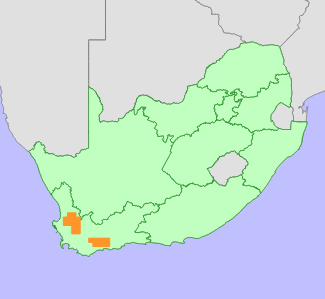|
Scientific Name | Protea piscina Rourke |
Higher Classification | Dicotyledons |
Family | PROTEACEAE |
Common Names | Skurweblaardwergprotea (a), Visgat Sugarbush (e) |
National Status |
Status and Criteria | Least Concern |
Assessment Date | 2019/06/10 |
Assessor(s) | A.G. Rebelo, H. Mtshali & L. von Staden |
Justification | Protea piscina is a range restricted but locally abundant species. It has an extent of occurrence (EOO) of 15 885 km². In spite of ongoing habitat degradation, it is not yet in danger of extinction. It is assessed as Least Concern. |
Distribution |
Endemism | South African endemic |
Provincial distribution | Western Cape |
Range | This species is endemic to the mountains of the Western Cape Province, South Africa, where it occurs from the Cederberg to Ceres, and along the Langeberg from Swellendam to Riversdale. |
Habitat and Ecology |
Major system | Terrestrial |
Major habitats | Piketberg Sandstone Fynbos, Winterhoek Sandstone Fynbos, Cederberg Sandstone Fynbos, Olifants Sandstone Fynbos, Graafwater Sandstone Fynbos, South Langeberg Sandstone Fynbos, North Langeberg Sandstone Fynbos, Swellendam Silcrete Fynbos |
Description | It grows in sandstone fynbos, 400-1200 m. It is a long-lived species, and survives fires by resprouting from underground stems. Wind-dispersed seeds are stored in fire-resistant inflorescences, and released after fires. It is pollinated by birds. |
Threats |
| At least 10% of this species habitat has been lost to crop cultivation and infrastructure development in the past, and loss continues (1% loss recorded between 1990 and 2014). It is threatened by ongoing habitat degradation by alien invasive plants.
Climate change models suggested that this species could decline by at least 30% by 2025 (Bomhard et al. 2005), but such drastic population reductions have fortunately not yet occurred. |
Population |
This species is abundant and occurs as scattered individuals in at least 75 localised populations (Rebelo, 2001). The population is not currently declining, but is likely to decline in future if ongoing habitat degradation from invasive alien plants is not managed.
|
Population trend | Stable |
Notes |
| The northern and southern subpopulations appear to have different habitat requirements and this species should perhaps be investigated to determine if they are different ecomorphs (Rebelo, pers. obs.). |
Assessment History |
Taxon assessed |
Status and Criteria |
Citation/Red List version | | Protea piscina Rourke | Least Concern | Raimondo et al. (2009) | |
Bibliography |
Bomhard, B., Richardson, D.M., Donaldson, J.S., Hughes, G.O., Midgley, G.F., Raimondo, D.C., Rebelo, A.G., Rouget, M. and Thuiller, W. 2005. Potential impacts of future land use and climate change on the Red List status of the Proteaceae in the Cape Floristic Region, South Africa. Global Change Biology 11(9):1452-1468.
Goldblatt, P. and Manning, J.C. 2000. Cape Plants: A conspectus of the Cape Flora of South Africa. Strelitzia 9. National Botanical Institute, Cape Town.
Manning, J.C. and Goldblatt, P. 2012. Plants of the Greater Cape Floristic Region 1: The Core Cape Flora. Strelitzia 29. South African National Biodiversity Institute, Pretoria.
Raimondo, D., von Staden, L., Foden, W., Victor, J.E., Helme, N.A., Turner, R.C., Kamundi, D.A. and Manyama, P.A. 2009. Red List of South African Plants. Strelitzia 25. South African National Biodiversity Institute, Pretoria.
Rebelo, T. 2001. Sasol Proteas: A field guide to the proteas of southern Africa. (2nd ed.). Fernwood Press, Vlaeberg, Cape Town.
|
Citation |
| Rebelo, A.G., Mtshali, H. & von Staden, L. 2019. Protea piscina Rourke. National Assessment: Red List of South African Plants version 2024.1. Accessed on 2026/01/07 |
 Comment on this assessment
Comment on this assessment

